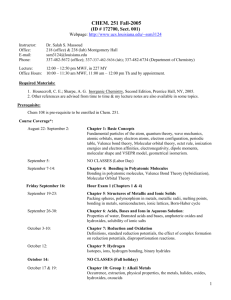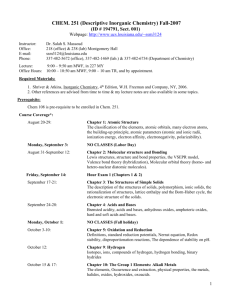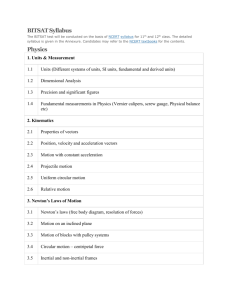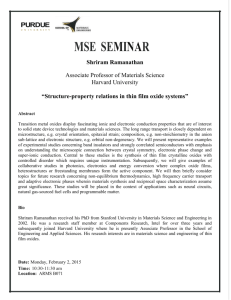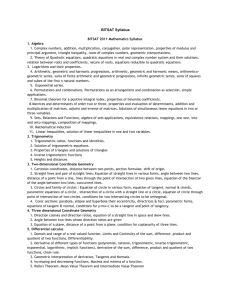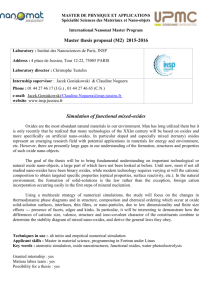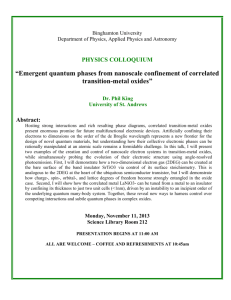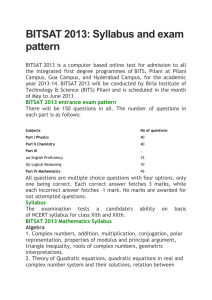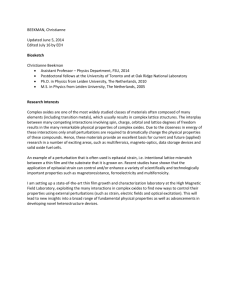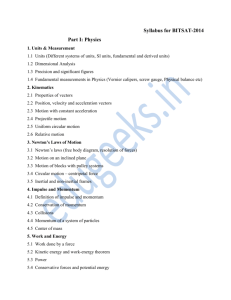Inorganic Chemistry
advertisement
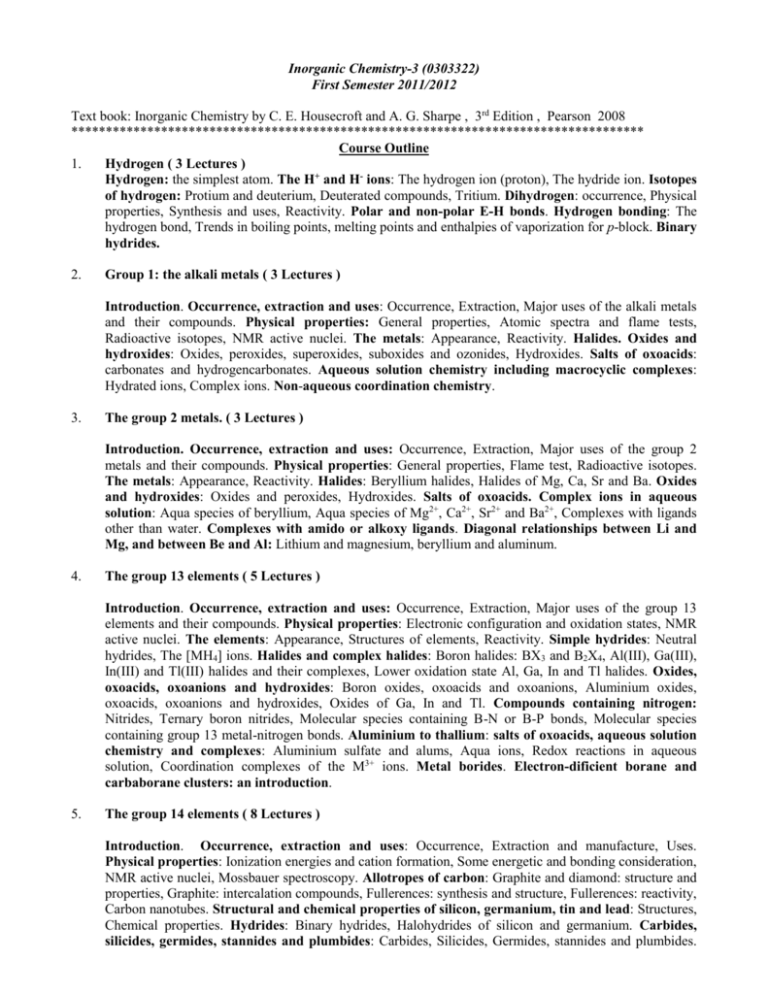
Inorganic Chemistry-3 (0303322) First Semester 2011/2012 Text book: Inorganic Chemistry by C. E. Housecroft and A. G. Sharpe , 3rd Edition , Pearson 2008 *********************************************************************************** Course Outline 1. Hydrogen ( 3 Lectures ) Hydrogen: the simplest atom. The H+ and H- ions: The hydrogen ion (proton), The hydride ion. Isotopes of hydrogen: Protium and deuterium, Deuterated compounds, Tritium. Dihydrogen: occurrence, Physical properties, Synthesis and uses, Reactivity. Polar and non-polar E-H bonds. Hydrogen bonding: The hydrogen bond, Trends in boiling points, melting points and enthalpies of vaporization for p-block. Binary hydrides. 2. Group 1: the alkali metals ( 3 Lectures ) Introduction. Occurrence, extraction and uses: Occurrence, Extraction, Major uses of the alkali metals and their compounds. Physical properties: General properties, Atomic spectra and flame tests, Radioactive isotopes, NMR active nuclei. The metals: Appearance, Reactivity. Halides. Oxides and hydroxides: Oxides, peroxides, superoxides, suboxides and ozonides, Hydroxides. Salts of oxoacids: carbonates and hydrogencarbonates. Aqueous solution chemistry including macrocyclic complexes: Hydrated ions, Complex ions. Non-aqueous coordination chemistry. 3. The group 2 metals. ( 3 Lectures ) Introduction. Occurrence, extraction and uses: Occurrence, Extraction, Major uses of the group 2 metals and their compounds. Physical properties: General properties, Flame test, Radioactive isotopes. The metals: Appearance, Reactivity. Halides: Beryllium halides, Halides of Mg, Ca, Sr and Ba. Oxides and hydroxides: Oxides and peroxides, Hydroxides. Salts of oxoacids. Complex ions in aqueous solution: Aqua species of beryllium, Aqua species of Mg2+, Ca2+, Sr2+ and Ba2+, Complexes with ligands other than water. Complexes with amido or alkoxy ligands. Diagonal relationships between Li and Mg, and between Be and Al: Lithium and magnesium, beryllium and aluminum. 4. The group 13 elements ( 5 Lectures ) Introduction. Occurrence, extraction and uses: Occurrence, Extraction, Major uses of the group 13 elements and their compounds. Physical properties: Electronic configuration and oxidation states, NMR active nuclei. The elements: Appearance, Structures of elements, Reactivity. Simple hydrides: Neutral hydrides, The [MH4] ions. Halides and complex halides: Boron halides: BX3 and B2X4, Al(III), Ga(III), In(III) and Tl(III) halides and their complexes, Lower oxidation state Al, Ga, In and Tl halides. Oxides, oxoacids, oxoanions and hydroxides: Boron oxides, oxoacids and oxoanions, Aluminium oxides, oxoacids, oxoanions and hydroxides, Oxides of Ga, In and Tl. Compounds containing nitrogen: Nitrides, Ternary boron nitrides, Molecular species containing B-N or B-P bonds, Molecular species containing group 13 metal-nitrogen bonds. Aluminium to thallium: salts of oxoacids, aqueous solution chemistry and complexes: Aluminium sulfate and alums, Aqua ions, Redox reactions in aqueous solution, Coordination complexes of the M3+ ions. Metal borides. Electron-dificient borane and carbaborane clusters: an introduction. 5. The group 14 elements ( 8 Lectures ) Introduction. Occurrence, extraction and uses: Occurrence, Extraction and manufacture, Uses. Physical properties: Ionization energies and cation formation, Some energetic and bonding consideration, NMR active nuclei, Mossbauer spectroscopy. Allotropes of carbon: Graphite and diamond: structure and properties, Graphite: intercalation compounds, Fullerences: synthesis and structure, Fullerences: reactivity, Carbon nanotubes. Structural and chemical properties of silicon, germanium, tin and lead: Structures, Chemical properties. Hydrides: Binary hydrides, Halohydrides of silicon and germanium. Carbides, silicides, germides, stannides and plumbides: Carbides, Silicides, Germides, stannides and plumbides. 2 Halides and complex halides: Carbon halides, Silicon halides, Halides of germanium, tin and lead. Oxides, oxoacids and hydroxides: oxides and oxoacids of carbon, Silica, silicates and aluminosilicates, Oxides, hydroxides and oxoacids of germanium, tin and lead. Silicones. Sulfides. Cyanogen, silicon nitride and tin nitride: Cyanogen and its derivatives, Silicon nitride, Tine(IV) nitride. Aqueous solution chemistry and salts of oxoacids of germanium, tin and lead. 6. The group 15 elements ( 7 Lectures ) Introduction. Occurrence, extraction and uses. Physical properties: Bonding considerations, NMR active nuclei, Radioactive isotopes. The elements: Nitrogen, Phosphorus, Arsenic, antimony and bismuth. Hydrides: Trihydrides, EH3 (E=N, P, As, Sb and Bi), Hydrides: E2H4 (E=N, P, As), Chloramine and hydroxylamine, Hydrogen azide and azide salts. Nitrides, phosphides, arsenides, antimonides and bismuthides: Nitrides, phosphides, arsenides, antimonides and bismuthides. Halides, oxohalides and complex halides: Nitrogen halides, Oxofluorides and oxochlorides of nitrogen, Phosphoryl trichloride, POCl3, Arsenic and antimony halides, Bismuth halides. Oxides of nitrogen: Dinitrogen monoxide, N2O, Nitrogen monoxide, NO, Dinitrogen trioxide, N2O3, Dinitrogen tetraozide, N2O4, and nitrogen dioxide, NO2, Dinitrogen pentaoxide, N2O5. Oxides of phosphorus, arsenic, antimony and bismuth: Oxides of phosphorus, Oxides of arsenic, antimony and bismuth. Oxoacids of arsenic, antimony and bismuth. Phosphazenes. Sulfides and selenides: Sulfides and selenides of phosphorus, Arsenic, antimony and bismuth sulfides. Aqueous solution chemistry and complexes. 7. The group 17elements ( 4 Lectures ) Introduction: Fluorine, chlorine, bromine and iodine, Astatine. Occurrence, extraction and uses: Occurrence, Extraction, Uses. Physical Properties and bonding considerations: NMR active nuclei and isotopes as traces. The elements: Difluorine, dichlorine, dibromine and diodine, Charge transfer complexes, Clathrates. Hydrogen halides. Metal halides: structures and energetics. Interhalogen compounds and polyhalogen ions: Interhalogen compounds, Bonding in [XY2]- ions, Polyhalogen cations, Polyhalide anions. Oxides and oxofluorides of chlorine, bromine and iodine: Oxides, Oxofluorides. Oxoacids and their salts: Hypofluorous acid, HOF, Oxoacids of chlorine, bromine and iodine. Aqueous solution chemistry. 8. Some aspects of solid state chemistry ( 3 Lectures ) Introduction. Defects in solid state lattices: Types of defect: stoichiometric and non-stoichiometric compounds, Colour centres (F-centres), Thermodynamic effects of crystal defects. Electrical conductivity in ionic solids: Sodium and lithium ion conductors, d-block metal (II) oxides. Superconductivity: Superconductors: early examples and basic theory, High-temperature superconductors, Superconducting properties of MgB2, Applications of superconductors. Ceramic materials: colour pigments: White pigments (opacifiers), Adding color. Chemical vapour deposition (CVD): High-purity silicon for semiconductors, -Boron nitride, Silicon nitride and carbide, III-V Semiconductors, Metal deposition, Ceramic coatings, Perovskites and cuprate superconductors. Inorganic fibers: Boron fibers, Carbon fibers, Silicon carbide fibers, Alumina fibers. Carbon nanotubes. 9. The trace metals of life ( 5 Lectures ):-Introduction: Amino acids, peptides and proteins: some terminology. Metal storage and transport: Fe, Cu, Zn and V: Iron storage and transport, Metallothioneins: transporting some toxic metals. Dealing with O2: Haemoglobin and myoglobin, Haemocyanin, Haemerythrin, Cytochromes P-450. Biological redox processes: Blue copper proteins, The mitochondrial electron-transfer chain, Iron-sulfur proteins, Cytochromes. The Zn2+ ion: Nature’s Lewis acid: Carbonic anhydrase II, Carboxypeptidase A, Carboxypeptidase G2, Cobalt-for zinc ion substitution. First Exam Second Exam Seminar Final Exam 20% 20% 10% 50% Office Hours: 8:00- 9:00 Su & Tu, 3:30- 4:30 M First Exam: Su 30/10/11 Second Exam: Tu 13/12/11
